Day 1 Hobart to Bruny Island
4 February 2018
This Tasmanian bird and mammal tour started with breakfast at the Old Wool Store in Hobart before heading to Mount Wellington. My usual MO is to tick off the Tasmanian scrubtit early as it can be a difficult bird to see and it’s always good to get it out of the way. That didn’t go to plan. Up in the wet forest on Mount Wellington it was cold and misty and the birds were quiet. We struggled to see anything initially but eventually managed a couple of juvenile pink robins followed a short time later by mum and dad pink robin. Tasmanian thornbills were about but we struggled to get decent views in the poor light. Tasmanian scrubwrens were lower down in the trees so we had better views of them. Sightings were also had of golden whistler, grey shrike-thrush and yellow-throated honeyeater. But generally, the going was tough.
Summerleas Road proved more fruitful and our first new bird along here was black currawong — surprising as I’d never, at this time of year, seen them at this lower elevation. Other species we saw as we travelled down the road included our first Tasmanian nativehens and New Holland honeyeaters and our first hairy echidna. A stop at a creek crossing proved productive and here we had both black-headed and strong-billed honeyeaters, which was good as there’s been big declines in both species in this area (and in Tasmania generally) since we first started coming here in the early 1990s. Other species here included spotted pardalote, green rosella, yellow-throated honeyeater, eastern spinebill and golden whistler. This more than compensated for our less-than-great morning on Mt Wellington and cheered the troops up no end as we headed for Margate for a picnic lunch at Dru Point Bicentennial Park. On North West Bay, we had our one and only great egret for the tour as well as our first pied oystercatchers and assorted other waterbirds.
We headed to Kettering after lunch to catch the ferry to Bruny Island. After disembarking, Trisha went ahead to prepare dinner at Inala and the group and I birded up the north end of Bruny. Dusky woodswallows seemed to have had a good year and we saw quite a few in our time on Bruny. Also in the dry woodland along the roadside we had our first dusky robin, brown thornbill and a pair of forty-spotted pardalotes. The forty-spots have become scarce up the north end of Bruny due to a lack of rainfall over many years, so nice to see them here. The eucalypts looked much healthier on North Bruny than I have seen them for many years. This apparently was due to good rain in December. As we made our way towards the isthmus, other sightings of note included grey butcherbird, a pair of brush bronzewings, scarlet robin and our first (Tasmanian) magpie. In the banksia scrub towards the isthmus we had a nice sighting of yellow-tailed black-cockatoos.
The mudflats along the isthmus produced our first sooty oystercatcher. On our way to South Bruny we stopped in the wetter forest and saw a cracking male flame robin as well as brown female plumaged birds. Also, a big group of yellow-rumped thornbills was seen here. The flame robin made our fourth and last possible robin species for the day. We made for our accommodation at Lunawanna but had one last stop at some mudflats. Here I was hoping for the elusive Lewin’s rail. We’ve been seeing them here on and off for over twenty years. This year was one of those years and we managed to lure a pair out and had some reasonable if brief views. Wow, the day may have started slowly but it had definitely improved. But there was more to come!
After dinner at Inala we headed out for some night spotting. Around Inala there were heaps of Bennett’s wallabies and Tasmanian pademelons. Some of the best spotting is up the north end of the island so we headed in that direction. Near the penguin rookery, along the isthmus, we had a little penguin trying to cross the new fence to get to the rookery from the inside channel. There are a few crossings under the road, which I guess the penguin would eventually find. Quite a few short-tailed shearwaters were flying around and a few crawling in the undergrowth searching for their nesting burrows.
Further north we started to see our first eastern quolls and although not in the numbers they have been in recent years, we had some great sightings of both colour phases along the road. A bit further up in one paddock bordered by forest we saw eight or so quolls out hunting. We saw more quolls in this one paddock than we saw for the rest of the night combined. Good numbers of the giant brush-tailed possum were seen all along the road although nothing like the numbers that were present in the 1990s. We crawled into bed about midnight after a day filled with exciting birds and mammals.
Day 2
5 February 2018 Bruny Island to Fentonbury.
I collected the troops this morning from the Explorer Cabins and brought them back to Inala where Trisha had breakfast ready. While the group was waiting for me, they had a wedge-tailed eagle fly over, the only sighting for the tour. Our first yellow wattlebirds were also seen in the trees about the cabins.
After a leisurely breakfast, we meandered around Inala. Forty-spotted pardalotes had bred well this season and there were quite a few about. Both black-headed and New Holland honeyeaters were also in the trees about the house and tree martins perched on the fence. The tree martins used to be more numerous on North Bruny but with the drying climate they appear to have largely shifted from North to South Bruny, which has a higher rainfall. Also in the paddocks nearby were quite a few uncoloured flame robins, and dusky and scarlet robins were seen on our walk as well. A single striated pardalote was also about here, seemingly not a common bird in Tasmania any more. In the forest behind the paddocks we briefly had a juvenile pink robin, making the fourth robin species for the morning walk.
The only olive whistler for the tour was also seen here but it was not co-operative and only brief views were had. We also had a lovely flock of strong-billed honeyeaters here, the first I have seen on Bruny for some years. There were juveniles in the flock as well, indicating a successful breeding season. A juvenile eastern spinebill was observed. A black currawong was heardl; I think the first I have heard at Inala.
Satisfied with our morning’s amble we headed across Mount Mangana to Adventure Bay, stopping to admire the flowering leatherwood trees that produce the distinctively flavoured honey. A couple of large flocks of yellow-rumped thornbills were seen in the open farmland, suggesting they too had bred successfully this season.
Strangely, it was time to eat again. At Adventure Bay we had another of Trisha’s picnic lunches before sauntering along the beach. Here we had our first pair of hooded plovers. It was great to see them sitting on a nest, as they were the previous year when we were here. There are several signs up to let people know they are nesting although the nest site is not roped off. Hopefully the young will make it through. A pair of Pacific gulls was also present on the beach, looking glammed up with their lipstick on.
The clock was ticking so we headed for the ferry. Our last bird for Bruny was white-bellied sea-eagle sitting in its favourite tree near the ferry terminal. I’ve been seeing it in this tree on and off for a couple of decades.
On the Tassie mainland we headed back through Hobart and up the Derwent Valley. We stopped on the Derwent River to check out a spot for Australasian bittern. No bittern was forthcoming but we were pleased to find a flock of 30 to 40 blue-winged parrots feeding in a weedy-looking area beside the river in company with a large flock of greenfinch and a smaller flock of goldfinch. I forget how attractive the blue-wings are until I see a full-coloured male; they really are a cracking bird. This was also to be our only sighting of blue-wings. Australian pipits were present here — another sole record for the tour. Several sightings were had of swamp harrier both on Bruny and along the Derwent.
We were greeted by a pair of yellow-tailed black-cockatoos feeding in an introduced pine tree on our arrival at Hamlet Downs Country Accommodation at Fentonbury.
Trisha relinquished responsibility for dinner to Jenifa, the owner of Hamlet Downs. Jenifa did us proud, making an Indian-inspired feast that included homemade naan. Very impressive! To paraphrase Albert, the Magic Puddin', ‘we didn’t leave the table till we were full up to the muzzle.’
Full to the muzzle or not, it was time for another night drive. We headed down a nearby back road. This road has been a good spot over the years for mammals particularly Tasmanian devil, and sometimes even a Tasmanian masked owl. We’ve had devils here for the past two years. Once upon a time, it was good for bettong but I’ve not seen them here now for ages. The usual pademelons, wallabies and brush-tailed possums were seen but no sign of devils. We tried a couple of spots for the masked owl. At one locality I thought I heard one but nothing came of it. We were all getting tired so we started heading homewards. I thought, damn it! I’ll give it one more go. Within minutes we had a huge female masked owl above us followed soon after by the male. Wow what a mega bird! We had plenty of opportunity for photos before we farewelled one of our great Australian birds. We were a bunch of happy campers when we crawled into bed about midnight.
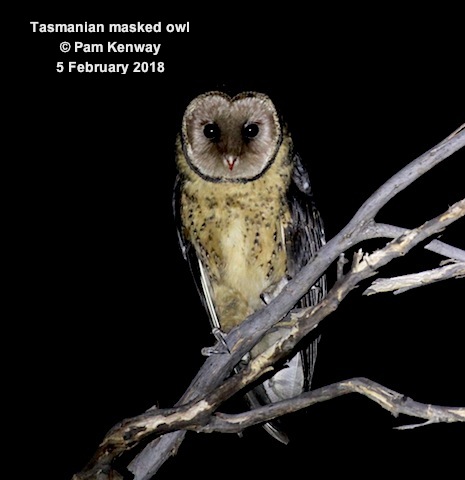
Day 3
6 February Fentonbury to Derwent Bridge.
We had a bit of a sleep in after our couple of nights spotlighting, and the plan was to go out again tonight. Trisha made breakfast at Hamlet Downs after which we were ready to face the day. First up, we birded along a forested road behind the accommodation. Brush bronzewing was calling incessantly but proved difficult to get our eyes on; eventually a bird being seen in flight. Along this road our one and only pallid cuckoo for the tour was observed, a juvenile bird not long fledged. Also along here we had our first satin flycatcher for the tour, an adult male. Honeyeaters were in good supply along this road and we had yellow-throated, black-headed and strong-billed. Robins also were well represented with scarlet, flame and dusky all being seen. Dusky woodswallows and silvereyes were numerous. Well-satisfied with our morning’s walk, we moved on. We tried a small stream up the road for platypus but it was not to be on this occasion.
We continued west to Derwent Bridge. Crossing a large water impoundment, we scored our first musk duck for the tour. A bit further west, a large roadside dam bolstered our waterfowl list. Here we added Australian shelduck, Australian shoveler, grey teal and hardhead to our lists as well as hoary-headed grebe.
We made the Central Highlands in good time. Raptors are generally quite scarce in Tasmania but we scored a brown falcon in some open farmland. A delightful pair of striated fieldwren was lured out of prickly hakea scrub. Continuing on to Derwent Bridge, another hairy echidna was seen on the roadside. We arrived at the designated lunch spot at Derwent Bridge and, uncharacteristically, I was too early! Trisha sent us away for half an hour. We chased some yellow wattlebirds around for a bit as the troops hadn’t seen one with long yellow wattles. Many of those we had seen had been juveniles and weren't full wattle. Black currawongs were about. We drove down the road to a patch of banksia scrub and after some effort had half-decent looks at our first crescent honeyeaters.
We settled into our cabins at Derwent Bridge Chalets after lunch and had a siesta. Mid afternoon, we headed further west untill we came to an area of temperate rainforest. When we arrived it was still hot by Tassie standards and there was no movement at all in the forest. We saw practically nothing on a short bushwalk but by the time we got back it had cooled down a bit and there was some bird activity. I was getting desperate for Tasmanian scrubtit now as we still had not so far seen it and were almost at our last chance. Plenty of Tassie scrubwrens were feeding low down and on the ground. When another bird was spotted low down feeding around a fallen log, I thought for sure it would be another scrubwren. Turned out to be a pair of scrubtits. I don’t remember ever seeing them feeding so low. Five minutes later they were working the trunk five metres up a tree, demonstrating the range of habitats this species can operate in. We had to work on them for about half an hour before everyone had satisfactory views. Boy, that was a close call! Plenty of Tassie thornbills were seen as we chased the scrubtits about. Back at the vehicle we had a lovely male pink robin. We headed back towards Derwent Bridge as I wanted to check out an area of button grass that sometimes has ground parrots in it. We tried hard for this species to no avail.
We were a little late returning to the chalets and had to go straight to dinner over at the Wilderness Hotel. The owners, David and Carol, were still at the pub. They were here when we first started doing Tasmanian tours over twenty years ago and now have the pub on the market. Carol hails from Wakool, which is only a stones throw from Deniliquin.
After dinner we headed out for another spotlight. A couple of the troops mutinied and had the night off. The rest of us headed off on our hunt for the devil. There were heavy showers as we headed off so how the night would pan out was anyone’s guess.
It was quiet at first; even the wallabies and pademelons are in far fewer numbers than when we first started coming up here. We spotted another echidna on the roadside and started seeing a few Bennett’s wallabies and Tassie pademelons. Brush-tailed possums were in good numbers with forty or so seen for the night. We saw baby possums almost as big as their mothers clinging to their mothers’ backs. A tawny frogmouth was seen along the road; again, our only sighting for the tour. We drove out quite a way before we eventually saw two eastern quolls, the first I have seen up here for a few years. We turned around and started for home.
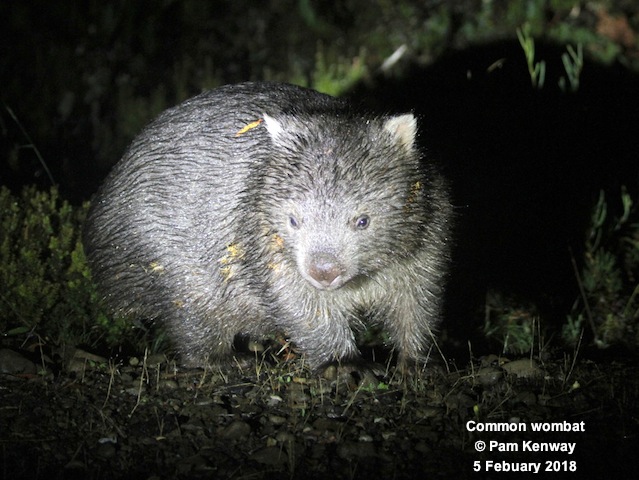
On the way back, no less than four common wombats were seen including one only a few metres from the vehicle. Pam got some great shots. Eventually I spotted a Tasmanian devil out the corner of my eye. We were a bit past it when I spotted the devil and I had to back up which meant it was already on the move when we were level with it. It was only a young devil, a bit over half grown but it is the first one we have seen up on the Central Plateau for a couple of years so hopefully they might be starting to build some resistance to the disease that’s been annihilating them.
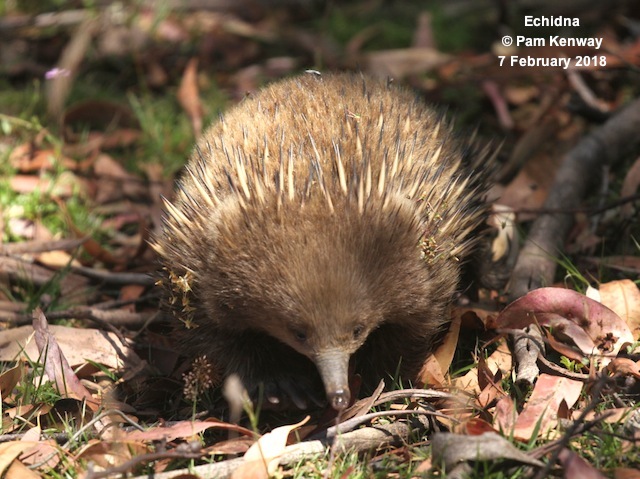
The excitement was not over yet. On the drive back a Tasmanian boobook was spotted on the roadside. The yellow eyes are such a notable feature of this species. We stumbled into bed about midnight, quite pleased with ourselves.
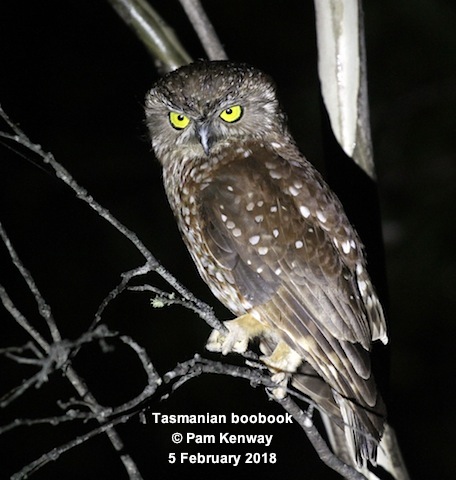
Day 4
7 February 2018 Derwent Bridge to Hobart.
After breakfast we headed down towards Lake St Clare and birded in an area of tall forest bordered by banksia scrub and teatree swamp. I noticed the tall eucalypts that often flower at this time of year were not flowering. As they often attract swift parrots I was a little concerned as that was our target species today. There was no sign of the swifties when we arrived but the area was alive with honeyeaters. We had good numbers of yellow-throated, black-headed, strong-billed and crescent as well as eastern spinebill. All the honeyeaters appeared to have juveniles with them, indicating a successful breeding season. The strong-billed particularly appeared to have lots of young. It wasn’t long before we heard our first swift parrots flying about but it took us quite a while before we had satisfactory views. At first they were feeding high up in the eucalypt leaves but after a while came right down and were feeding on the banksia flowers. (I think this is the first time I have ever seen them feed in banksia flowers. Last year we had one bird feeding in melaleuca flowers, which was also a first for me). All up, about 30 to 40 swift parrots were seen and a fair number of them were juveniles, demonstrating they too appeared to have had a successful breeding season. This is good news as they have been suffering from predation from the introduced sugar glider.
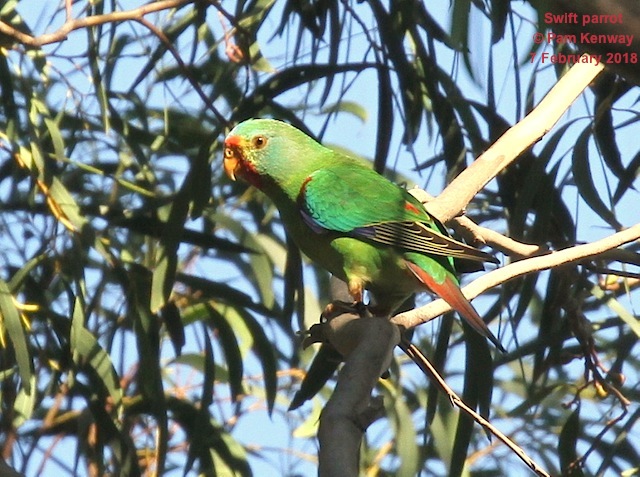
A couple of Latham’s snipe flushed up around a swampy area, another new bird for the tour.
Bill from Montana was our only American birder on the tour. (And delightful he was too!). Along the road we met a woman who lives not far from where Bill lives. What are the chances!
We tried around the swampy areas for beautiful firetail but this species seems to be greatly diminished on the Central Plateau. It is quite a few years since I have had them here. We also searched in vain for southern emuwren, another species that seems to be disappearing from the Plateau. Admittedly, it was becoming rather hot as we’d spent quite a bit of time looking at the swift parrots so it is quite possible the emuwrens were lying doggo. We did see some very recently fledged yellow wattlebirds around the swampy area. They are such a huge honeyeater with a long tail; it must be a sight to see the young in the nest. All the honeyeaters in Tasmania seem to have had a successful breeding season. Yet, the firetails and emuwrens seem to be still going downhill. The swamps up here where the emuwrens and firetails lived are very dry now. When we first started coming up here they were full of frogs and tiger snakes, both of which have largely gone.
Both male and female satin flycatchers were seen here and put on a show for us coming down almost to the ground.
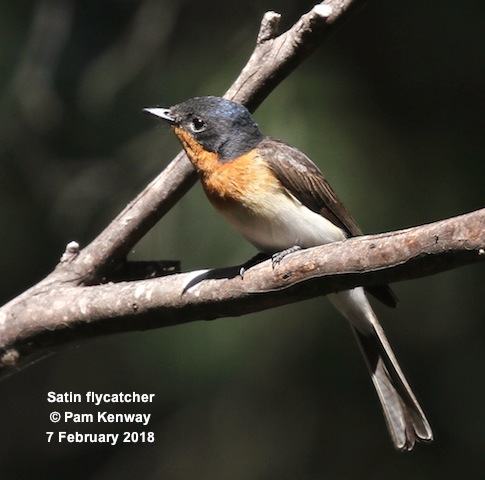
After a good morning’s birding we started back to Derwent Bridge for another picnic lunch.
We headed down the Derwent towards Hobart early afternoon. Near Gretna, we stopped at a large dam and had our only Cape Barren goose for the tour. This solitary bird seems to have been here for several years now. A black-fronted dotterel was seen briefly in flight but landed behind a bank and I was the only one to see it. Again, an only sighting for the tour.
We called in at the Tall Trees Walk at Mt Field NP on the way back to Hobart. The trees were magnificent but we did not add anything new to the list. We arrived back in Hobart in good time for dinner.
Terry and Roksana, two of our A list clients, joined us in the evening at the Old Wool Store and were with us for the next three days.
Day 5.
8 February Hobart Melaleuca Sorell Hobart.
Off to Cambridge Airport for our morning flight to Melaleuca. Susanna, another A lister, joined us for the morning. Our pilot Bec, looked like she was barely out of high school but that may have more to do with my age than hers. She was an excellent pilot.
The sky was overcast but it was high cloud so we could fly under it and had great views of the forest and mountains. Most of the old growth forest has been taken out in the last twenty years and replaced with plantations. There is still a small amount of old growth left, mainly on the western side before the rugged mountains. The scenery in the mountains is some of the best in Australia. The weather was dead calm and I think it was one of the smoothest flights I’ve ever had to Melaleuca.
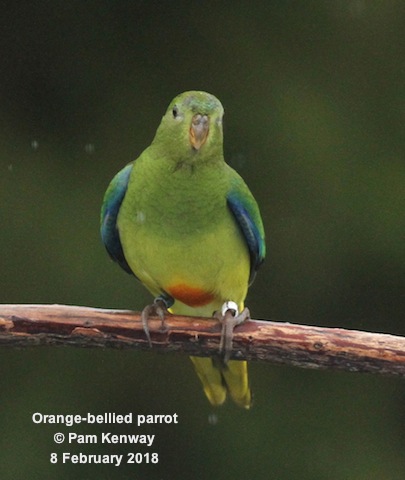
We arrived at Melaleuca and proceeded to the main hide. One orange-bellied parrot, a male, was in attendance at the feeding station along with several (mainly) immature beautiful firetails. One of the volunteer wardens had to clean the feeding station so the birds had a break for a while. We had some morning tea provided by Bec while this was happening. When more feed was put out about four OBPs came in as well as more beautiful firetails. We enjoyed some nice looks in the scope of adult and juvenile birds of both species. A couple of small native rodents were foraging about under the feeding station. Judging by their shape and the pale colour of the hind feet I believe they were Broad-toothed mouse Mastacomys fuscus.
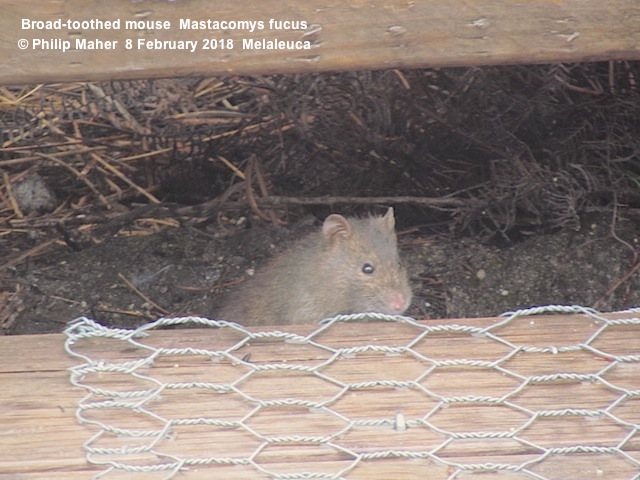
We searched around the airfield for southern emuwren but none was forthcoming. We did manage to find superb fairywrens and another pair of striated fieldwrens. Down towards Wilson’s abandoned mine, where there is another feeding station, more OBPs were seen with some hanging around nest boxes. They say there's about forty adult OBPs left, most of which are captive-bred birds. The volunteer warden was not allowed to tell us how many young had fledged this season — it’s top secret. The grapevine has it that thirty-four young were hatched this season. Only two wild females returned to Melaleuca this season. To state the bleeding obvious, the species is in dire straits in the wild.
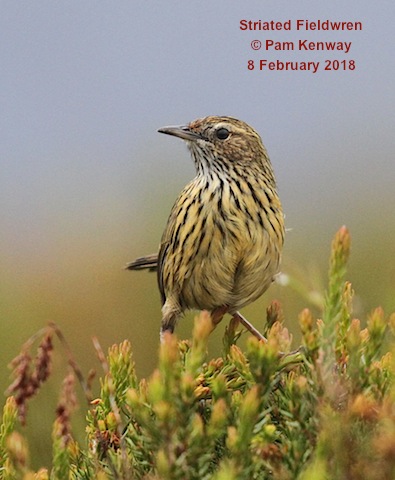
We spent the rest of our time at Melaleuca searching for southern emuwren and ground parrot but struck out on both counts. Difficult to figure out what goes on with ground parrots, some years we get them easily, yet other years they are impossible. As a last resort, we tried to flush some out of the heath and the troops put in a valiant effort and all deserved a commendation. Having got distracted with our search we were late getting back for the plane. Bec, our pilot, didn’t give me a dressing down and even took us back around the slightly longer and spectacular coastal route.
Back on the ground, we said goodbye to Susanna and headed for Sorell where Trisha had lunch waiting for us. As we crossed the second causeway we had a nice flock of bar-tailed godwits fly alongside us, and a few musk ducks and great-crested grebes were noted.
After lunch we checked out the mudflats about Sorell for waders and waterbirds. Orielton Lagoon was productive this year despite Terry and Roksana trying to tell me it was dry when they called in there a few days ago. I think it was the best I’ve seen it since before they reopened the causeway about twenty years ago. This year we counted (more or less) nine eastern curlew, twenty greenshank, eight red-necked stint, six sharp-tailed sandpiper, fifty Pacific golden plover, ten red-capped plover. Our best sighting was a single pectoral sandpiper feeding with the sharpies. I’ve not had a pectoral here for over twenty years. Other sightings of note here included one little egret, hundreds of kelp gull at a nesting colony where most young appeared to have fledged and Caspian tern. Some nice bush birds were had about here as well and we added brown falcon, galah, musk lorikeet, eastern rosella, noisy miner and skylark. The eastern rosellas over here are much more yellow on the sides of the breast and about the nape than the ones on the mainland.
Our last stop for the day was in some dry woodland back near Hobart. Hobart birder, Els Wakefield, had put me onto an owlet nightjar living in a treehollow here and I hoped to get it on our lists. I had never seen one in Tasmania in over twenty years of tours and I’ve only ever heard three birds call in all that time. It wasn’t in its regular hollow but I found it nearby and it went back to its regular hollow and glared out at us. We couldn’t see the whole bird but it appeared a lot darker on the breast than the mainland bird. They must have been isolated in Tasmania for a very long time — a split down the line perhaps? A lovely male spotted pardalote was also seen in the woodland and a falcon was dashing about overhead that I believe after review of Terry’s photo was an Australian hobby. I thought, at first, it might have been a peregrine. We called it a day and headed for Hobart Town.
Day 6
9 February 2018 Hobart Orford Eaglehawk Neck
The day's birding started at the Waterworks Reserve, hoping for painted buttonquail. We searched an area of dry forest with a rushy understory and saw a pair of satin flycatchers as well as several brown thornbills and black-headed honeyeaters but no buttonquail. A pit stop at the picnic area proved worthwhile for more than the obvious reasons. The group finally had good looks at the giant yellow earrings of adult yellow wattlebirds. We also had more strong-billed honeyeaters making it five days out of six that we had seen them on this year’s tour. The species has become quite scarce over the last decade or so and some years we have only seen them on one day of the tour. So it seems they may be making a bit of a comeback. Good views were also had of male scarlet robin and after some effort we saw our first fan-tailed cuckoo for the tour. Another pair of satin flycatchers was seen and more dusky robins. It was time to head for Orford as Trisha was expecting us there for lunch. En route we called in at a large farm dam where I have had a platypus two years running but not on this occasion.
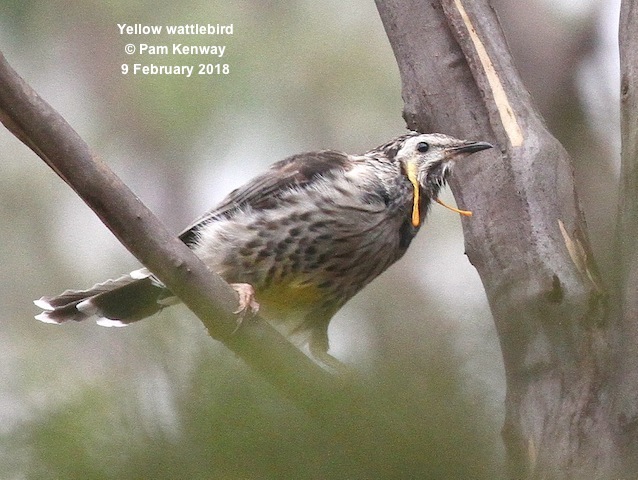
Trisha had our last picnic lunch waiting for us when we arrived in Orford. (Tomorrow we’d be out at sea). Plenty of both yellow and little wattlebirds were about the picnic area and the most beautiful pair of galahs I think I’ve ever seen were sitting quietly in a shady tree. In a nearby tree a male magpie was rendering a lovely quiet song with a lot of mimicking in it.
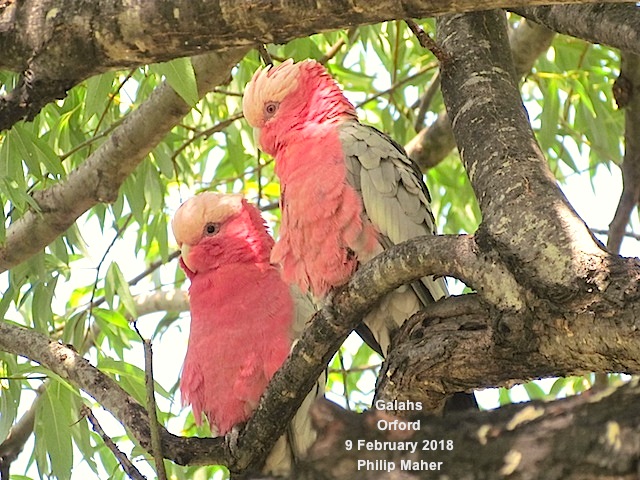
We drove around to the mouth of the river after lunch and then walked along the foreshore. There’s been a lot of earthworks going on at the mouth of the river so I was not sure what effect it was going to have on the hooded plover and other species that breed there.
We soon found a pair of hooded plover that had a single small chick out on the sandbar so they are still breeding at this stage. Pied oystercatchers also had a full-grown immature bird with them. Better looks were had of little wattlebirds in the banksias along the foreshore. We walked out along the beach to the mouth of the river and were delighted to find about eight fairy terns, some sitting on the artificial sandbars. Apparently they have not bred here so far this season; perhaps upset by the earthworks. On the sandbar nearby about a dozen hooded plover were lolling on the sand including a pair with two full-grown juveniles. Perhaps the most hooded plover I’ve seen at this locality.
We drove up beyond Triabunna to a large wetland. A good number of waterfowl were present including eight blue-billed ducks, the first for the tour. Other waterfowl here included about thirty Australasian shoveler, two hundred chestnut teal and at least three hundred Eurasian coot.
We turned around and headed south for Eaglehawk Neck. On the way, in the samphire flats at Marion Bay, white-fronted chats were added to our list. We tried hard for spotted crake, which is often present here but was not on this occasion. Waders seen nearby included three common greenshank, ten red-necked stint and about thirty pied oystercatchers plus another little egret.
With ‘time and tide waiting for no man’ we made tracks for the Old Convict Station at Taranna. We dined at GabrieI’s by the Bay and I had a brief try near the restaurant for Tasmanian boobook for Terry and Roksana who hadn’t been with us when we had seen the one up at Derwent Bridge, but no luck. After another full day, we had an early night. We had the pelagic tomorrow.
Day 7
10 February 2018 Pelagic boat trip off Eaglehawk Neck. Return to Hobart.
We set off from dock a bit after 7 am with 10 participants on board plus our captain John Males and deckhand Heath and me. The sea was fairly flat on the way out but the northeasterly wind picked up as the day went on and by the time we were coming back in, it was decidedly rocky.
We were not far out of the bay when the first wedge-tailed shearwaters were spotted. These were a major rarity off Tasmania twelve months ago when I saw my first one here. Now they are being recorded regularly and, by my count at least, six were present today, all well inside the shelf. (As the sea temperatures are rising, more and more of these sub-tropical species are being seen off Tasmania. Perhaps it won’t be long before they are breeding down here).
A small pod of common dolphins was also seen not far out of the bay but did not follow the boat for long.
Also with the wedge-tailed shearwaters, another small very black and white shearwater was seen which we thought at the time may have been a little shearwater. Several photos were taken of the bird which was a bit too far out to identify with binoculars. Seabird experts could not be sure if it was little or fluttering shearwater so we’ll let that one go through to the keeper. All I could say about it was that it looked very white underneath. When in doubt, leave it out.
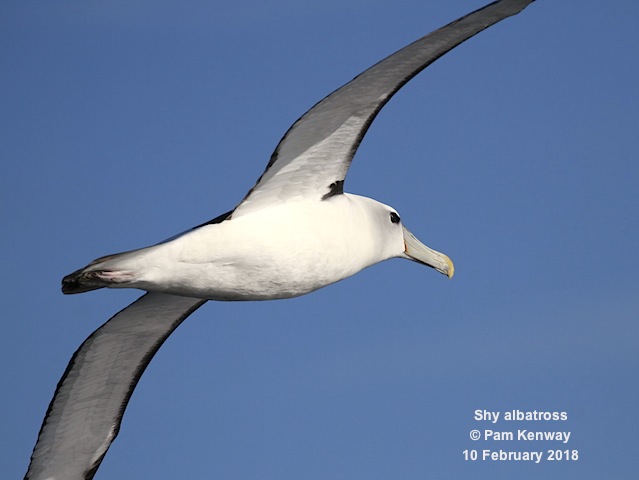
Also on the way out (and on the way back in) common diving petrels were seen but the views were brief and probably only a few of those on board had any sort of a view. A few fairy prions were also seen on the way out and coming back in and some reasonable views were had of this species. Our first shy and Buller’s albatrosses were observed on our way out to the Hippolyte Rocks and we had a few fluttering shearwaters and started seeing the first of many short-tailed shearwaters.
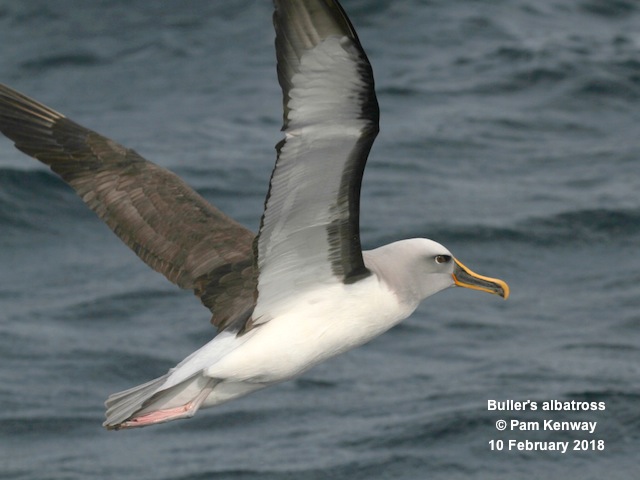
Various petrels were also seen both inside and over the shelf. Only one soft-plumaged petrel came close and even then the views were fairly brief. (It was a frustrating day in many respects). Other distant petrels that could only be identified by photographs taken by Els Wakefield and Peter Vaughan included Cook’s and Gould’s. Hutton's shearwater was also only identified from Els' and Peter's photos.
At the Hippolyte Rocks several hundred black-faced shags were nesting. A white-bellied sea-eagle, attempting to take young from the nest, wreaked havoc among the shags. Birds were going in all directions. A score or more of Australasian gannets and plenty of kelp gulls were about the Rocks and a couple of Pacific gulls were sitting on top of the Little Hippolyte Rock. Small numbers of Australian fur seals were loafing about.
Beyond the Hippolytes we started seeing big numbers of short-tailed shearwaters and a guesstimate of a couple of thousand birds were observed during the day. The odd sooty shearwater was recorded with at least one seen over the shelf.
We finally saw our first white-chinned petrel, indicating we had reached the shelf. A bit over the shelf we had our first stop and our deckhand Heath started putting out burley. We soon had thirty or so shy albatross about the boat as well as several white-chinned petrels and our first grey-faced petrels. White-faced storm-petrels were also around in good numbers although no grey-backed were seen which is possibly the first time I’ve ever missed this species off here. We searched hard for rarities but they were few and far between. Eventually we had a nice Buller’s shearwater come in close and we had a good, albeit, brief view of it. This was followed soon after by a banded Gibson's albatross with a red colour band on the right leg (silver on the left) with blue colour dye on its head. This bird turned out to be a male Gibson's albatross, banded on a nest on Adams Island, part of the Auckland Islands archipelago. The blue dot on its head is to show from a distance that it's already been banded. A northern giant petrel also came in, allowing good views. Great views were had of Buller’s albatross, which were continually around the boat. This is also when we had our best views of the aforementioned soft-plumaged petrel but like the Buller’s shearwater only made one pass.
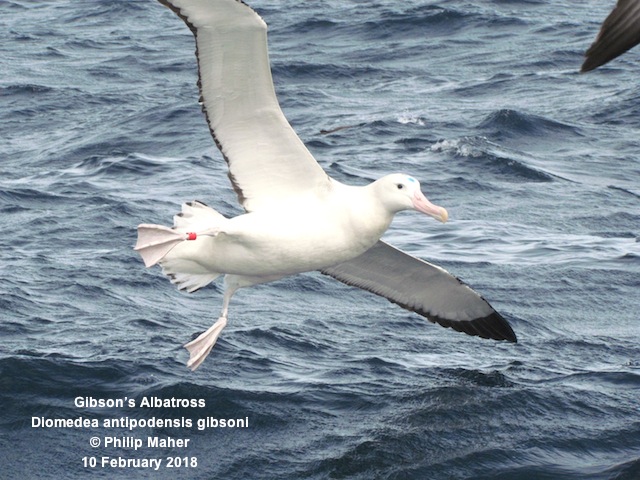

With nothing new coming in we decided to try another spot. The captain went a little further north so we would have a smoother ride back in as the sea was coming from the northeast. At the second stop over the shelf we had a lovely adult Indian yellow-nosed albatross come in and land on the water. A single Wilson’s storm-petrel came in as well, our only sighting for the day. There was quite a big swell now. The captain thought it time we started heading in given it was going be a slow trip back. We had not gone far when a single immature black-browed albatross was spotted behind the boat. A couple more northern giant petrel were seen on the way back in and several more distant sightings were had of soft-plumaged petrel well inside the shelf.
With the big sea, a couple of the troops were feeling a bit seedy on the way back in. Landfall couldn’t be soon enough!
All in all, we didn’t do too badly and some nice sightings were had. Some of the folks had not been out on the ocean before so most birds were new for them. For some of the more experienced seabird watchers on board it would have been nice if some of the petrels had come in a bit closer.
People suddenly found their appetites when we were back on dry land and the pile of sandwiches that Trisha had made soon disappeared. We said our goodbyes to our Tasmanian companions Susanna, Els, Peter and Heather who had joined us for the day and also goodbye to Roksana and Terry who were heading over to the west coast. The rest of us headed for Hobart.
Many thanks to Pam, Wendy, Julie and Bill for sharing this Tasmanian adventure with us, all new to AOS, and it’s always lovely to see tour veterans, Susanna, Terry and Roksana.
A special thank you to Pam for her great photos. She's infinitely a better photographer than I am.
Checklist of species seen on the 2018 Tasmanian bird and mammal tour
Next year's Tasmanian bird and mammal tour dates are 3 to 9 February 2019.
|











